To infinity and beyond
How modern presidents have sought to explore the New Frontier
It suddenly struck me that that tiny pea, pretty and blue, was the Earth. I put up my thumb and shut one eye, and my thumb blotted out the planet Earth. I didn't feel like a giant. I felt very, very small.
—Neil Armstrong
Our fascination with space exploration is about as American as apple pie. The modern US space program began in earnest during the presidency of Dwight Eisenhower—and has continued throughout the subsequent 11 administrations. Here's a brief look back at each president’s quest to explore our universe.
1. Dwight D. Eisenhower, 1953–61

Cold War tensions were at their peak in 1957. In October of that year, the Soviet Union launched the Sputnik satellite into Earth’s orbit, successfully drawing the United States into what would eventually be called the “space race”—a competition to see who could first land a man on the moon. Six months later, President Eisenhower recommended the formation of a civilian agency to direct space exploration—what we now know as NASA. Here is a portion of Eisenhower's statement upon signing the National Aeronautics and Space Act of 1958 (dated July 29).
I have today signed H. R. 12575, the National Aeronautics and Space Act of 1958. The enactment of this legislation is an historic step, further equipping the United States for leadership in the space age. . . .
The present National Advisory Committee for Aeronautics (NACA), with its large and competent staff and well-equipped laboratories, will provide the nucleus for the NASA. The NACA has an established record of research performance and of cooperation with the Armed Services. . . .
The enactment of the law establishing the NACA in 1915 proved a decisive step in the advancement of our civil and military aviation. The Aeronautics and Space Act of 1958 should have an even greater impact on our future.
2. John F. Kennedy, 1961–63
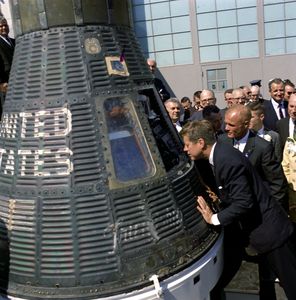
Kennedy is the president perhaps most associated with the US space program. Not only was NASA's Kennedy Space Center in Florida named for him soon after his assassination, but the day Neil Armstrong first walked on the moon in 1969, someone anonymously left flowers on his grave, along with a note that read, “Mr. President, the Eagle has landed.”
Imbued with a sense of historical grandeur, Kennedy’s speech at Rice University in Houston on September 12, 1962, frames putting a man on the moon as a pivotal moment in human advancement, and in America's struggle for international preeminence.
“There is no strife, no prejudice, no national conflict in outer space as yet,” Kennedy said. “Its hazards are hostile to us all. Its conquest deserves the best of all mankind, and its opportunity for peaceful cooperation may never come again. But why, some say, the moon? Why choose this as our goal? And they may well ask why climb the highest mountain. Why, 35 years ago, fly the Atlantic? Why does Rice play Texas? We choose to go to the moon. We choose to go to the moon in this decade and do the other things, not because they are easy, but because they are hard. . . .”
Watch the entire speech below.
From the John F. Kennedy Secret White House Tapes
Worried about the political ramifications of promising the moon and not being able to deliver, scientists, policy advisors, and the head of NASA met with President Kennedy on November 21, 1962, to express concerns over trying to launch a lunar mission before first conducting space experiments. Kennedy pressed the men to make the mission the number one priority.
This is, whether we like it or not, in a sense a race. If we go up second to the moon, it’s nice but it’s like being second any time. . . . I think we have to take the view this is the top priority. . . . It certainly is mine.
Professor of electrical engineering Jerome “Jerry” Wiesner explains why methodical study is an important first step:
We don’t know a damn thing about the surface of the moon and we're making the wildest guesses about how we're going to land on the moon. And we could get a terrible disaster from putting something down on the surface of the moon that's very different than what we think it is.
But Kennedy presses on.
The fact that the Soviet Union has made this a test of the systems. . . . So I think we’ve got to take the view that this is the key program. And the rest of it, God . . . we can find out about it, but there’s a lot of things we want to find out about. . . . I think that everything that we do ought to really be tied into getting onto the moon ahead of the Russians. . . . We’ve been telling everybody we’re preeminent in space for five years and nobody believes us because [the Soviets] have the booster and the satellite.
3. Lyndon B. Johnson, 1963–69
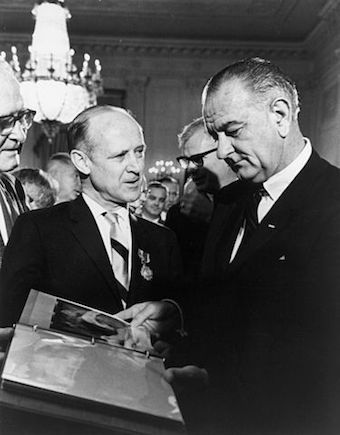
President Johnson was committed to the space program long before he became president. As Senate Majority Leader, he pushed a reluctant Eisenhower to ramp up US space efforts after the Soviets launched Sputnik. "Johnson can keep his head in the stars if he wants," Eisenhower said of Johnson at the time. "I'm going to keep my feet on the ground."
Then in 1961, Vice President Johnson wrote a memo to then-President Kennedy, evaluating the status of the US space program. “This country should be realistic and recognize that other nations, regardless of their appreciation of our idealistic values, will tend to align themselves with the country which they believe will be the world leader—the winner in the long run,” Johnson explained. “Dramatic accomplishments in space are being increasingly identified as a major indicator of world leadership.”
On the day of the Apollo 11 launch in 1969—a mission that would bring the first men to the moon—Johnson spoke with legendary newsman Walter Cronkite about the historical importance of the event. “As they took off this morning,” he said, “I thought about how fortunate we’ve been all these years. If we can do all of that in such a short time, I wonder why it is that we can’t put that same effort to bring good and peace to all the world. . . . I don’t believe there’s a single thing that our country does…that has greater potential for peace than the space effort.”
As president, Johnson was committed to Kennedy's goal of reaching the moon by the end of the decade. On a Miller Center's Secret White House conversation from March 23, 1965, you can listen to Johnson’s prescience when speaking with Democratic Senator John McClellan of Arkansas about the long-lasting implications of the work: “This research is the most important thing we can do. . . . Seventy-five percent of the things we will be making 25 years from now, we have never heard of now. That’s how fast the world changes.” Listen to the conversation here.
4. Richard M. Nixon, 1969–74
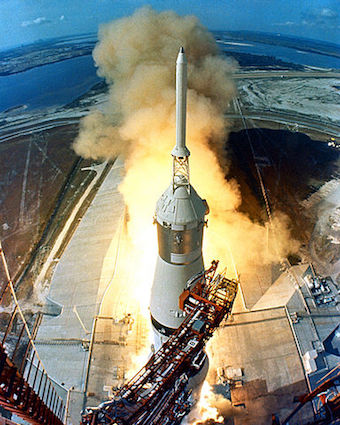
Richard Nixon was president on July 20, 1969, when Apollo 11 landed on the moon and Neil Armstrong took those momentous first steps for mankind. Nixon viewed the expedition as not just a victory for American scientific advancement but also for diplomacy. “For every American, this has to be the proudest day of our lives,” he told Armstrong in an historic phone call from the White House to the moon. “And for people all over the world I am sure that they, too, join with Americans in recognizing what an immense feat this is.”
Watch and listen to the phone call he made to the astronauts of the Apollo 11.
5. Gerald R. Ford, 1974–77
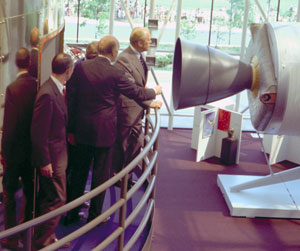
A staunch supporter of the US space program, President Ford had believed in it since the time he was a member of the House Select Committee on Astronautics and Space Exploration. Ford was in the White House during the successful Apollo-Soyuz and the landings of the twin Viking robotic explorers on Mars in 1975. He also opened the Smithsonian National Air and Space Museum in Washington DC in July 1976.
Also in 1976, during the US Bicentennial celebrations, he spoke of the space program as the “great American adventure”: “The hallmark of that adventure has always been an eagerness to explore the unknown, whether it lay across an ocean or a continent, across the vastness of space or the frontiers of human knowledge.”
6. Jimmy Carter, 1977–81
As an engineer and former nuclear submarine Navy lieutenant, President Carter had a deep understanding of science. That said, he was often mocked for his report of a UFO sighting while he was governor of Georgia.
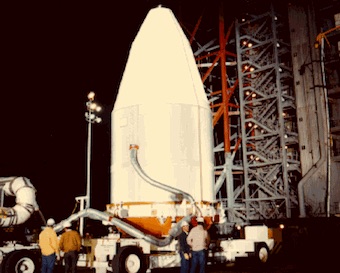
During his tenure as president, Carter oversaw the launches of Voyager I and II—two missions to explore the giant planets of our outer solar system (the first in history to reach interstellar space). Onboard were a variety of writings and American mementos, just in case the aircrafts were to encounter other forms of life. The greetings included a 12-inch gold-plated copper disc containing sounds and images of Earth, musical selections, and handwritten notes. Carter wrote this to be included onboard:
Voyager Spacecraft Statement by the President
July 29, 1977
This Voyager spacecraft was constructed by the United States of America. We are a community of 240 million human beings among the more than 4 billion who inhabit the planet Earth. We human beings are still divided into nation states, but these states are rapidly becoming a single global civilization.
We cast this message into the cosmos. It is likely to survive a billion years into our future, when our civilization is profoundly altered and the surface of the Earth may be vastly changed. Of the 200 billion stars in the Milky Way galaxy, some—perhaps many—may have inhabited planets and spacefaring civilizations. If one such civilization intercepts Voyager and can understand these recorded contents, here is our message:
This is a present from a small distant world, a token of our sounds, our science, our images, our music, our thoughts, and our feelings. We are attempting to survive our time so we may live into yours. We hope someday, having solved the problems we face, to join a community of galactic civilizations. This record represents our hope and our determination, and our good will in a vast and awesome universe.
7. Ronald Reagan, 1981–89
“We will never forget them, not the last time we saw them this morning as they prepared for their journey and waved goodbye and slipped the surly bonds of earth to touch the face of God,” President Reagan said on January 28, 1986, as he addressed the nation after the space shuttle Challenger tragically exploded a little more than a minute into its mission, killing all seven astronauts onboard. This tragedy put space flights on hold for several years.
8. George H.W. Bush, 1989–93
On the 20th anniversary of the Apollo 11 moon landing, President Bush announced the Space Exploration Initiative, which he said would include “a long-range, continuing commitment.” For the 1990s, his goal was the Space Station Freedom, an early iteration of what would become the International Space Station. Bush’s plan for the next century was to go back to the moon—this time to stay—and then to Mars. “Why the moon? Why Mars?" he said. “Because it is humanity’s destiny to strive, to seek, to find. And because it is America’s destiny to lead. From the voyages of Columbus to the Oregon Trail to the journey to the moon itself—history proves that we have never lost by pressing the limits of our frontiers.”
9. Bill Clinton, 1993–2001
Under President Clinton, the space station Freedom was reconfigured so that the United States could partner with Russia, sending international scientists and astronauts to live and work together in outer space. In his 1994 State of the Union address, Clinton highlighted this milestone: “This is a promising moment. Instead of building weapons in space, Russian scientists will help us build the International Space Station.”
In a 1996 speech, Clinton announced NASA’s discovery of bacterial life on Mars. “I am determined that the American space program will put its full intellectual power and technological prowess behind the search for further evidence of life on Mars,” Clinton said. “I have asked the vice president to convene at the White House before the end of the year a bipartisan space summit on the future of America’s space program.”
10. George W. Bush, 2001–09
“The cause of exploration and discovery is not an option we choose; it is a desire written in the human heart,” said President Bush at the memorial for the seven astronauts killed after the US space shuttle orbiter Columbia broke apart during reentry on February 1, 2003. “We are that part of creation which seeks to understand all creation. We find the best among us, send them forth into unmapped darkness, and pray they will return. They go in peace for all mankind, and all mankind is in their debt.”
After the disaster, NASA investigated the accident and made recommendations for a strategic plan going forward. Bush detailed that plan in a 2004 speech, setting his goal no closer than the entire solar system. He outlined three goals: First, to complete the International Space Station by 2010. Second, to develop and test a new spacecraft called the Crew Exploration Vehicle, which would be able to take astronauts and scientists to and from the space station after the shuttle was retired. And third, to return to the moon by 2020, using it as a “launching point for missions beyond.”
11. Barack Obama, 2009–16
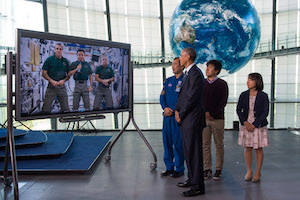
President Obama considered himself to be of the generation inspired by America's greatest early expeditions into space. “Nineteen sixty-one was the year of my birth—the year that Kennedy made his announcement,” Obama said in a speech in 2010. “One of my earliest memories is sitting on my grandfather’s shoulders, waving a flag as astronauts arrived in Hawaii. For me, the space program has always captured an essential part of what it means to be an American: reaching for new heights, stretching beyond what previously did not seem possible. And so, as president, I believe that space exploration is not a luxury, it’s not an afterthought in America’s quest for a brighter future. It is an essential part of that quest.”
In that same speech, Obama outlined his vision for the future of space exploration: “By 2025, we expect new spacecraft designed for long journeys to allow us to begin the first-ever crewed missions beyond the moon into deep space. . . . We'll start by sending astronauts to an asteroid for the first time in history. By the mid-2030s, I believe we can send humans to orbit Mars and return them safely to Earth. And a landing on Mars will follow. And I expect to be around to see it.”
12. Donald Trump, 2016–
“The future of American space leadership—we’re going to lead again,” said President Trump in June 2017 at a ceremony with former astronaut Buzz Aldrin celebrating the signing of an executive order to resurrect the National Space Council. “It’s been a long time. It’s over 25 years, and we’re opening up, and we are going to be leading again like we’ve never led before. We’re a nation of pioneers, and the next great American frontier is space. . . . We started, but we never completed. We stopped. But now we start again. And we have tremendous spirit, and we're going to have tremendous spirit from the private sector—maybe in particular from the private sector.”
The National Space Council was originally formed by President Eisenhower in 1958. Trump appointed Vice President Mike Pence as chairman; also on the advisory board are Secretary of State Rex Tillerson, Secretary of Defense James Mattis, other cabinet members, the NASA administrator, and other government officials.